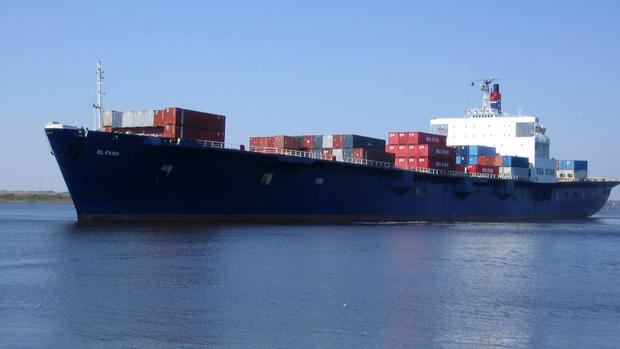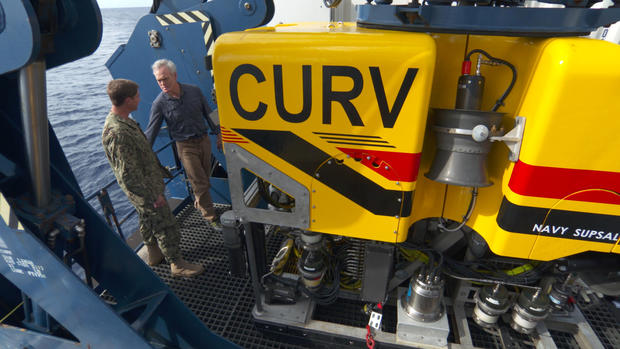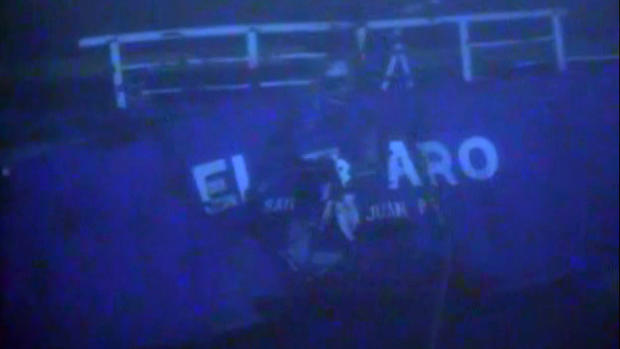Lost in the Bermuda Triangle
The following is a script from "Lost in the Bermuda Triangle" which aired on Jan. 3, 2016. Scott Pelley is the correspondent. Patricia Shevlin and Miles Doran, producers.
This past October, Hurricane Joaquin became the deadliest Atlantic storm since Sandy. But Joaquin didn't even brush the U.S. coast. The most powerful Atlantic cyclone in five years found its victims at sea -- 33 men and women onboard an American ship called El Faro. She was lost in the Bermuda Triangle, carrying a mystery to a grave deeper than the Titanic's. The greatest loss of a U.S. ship in 35 years. The National Transportation Safety Board has allowed us inside its investigation to show the enormous challenges. It intends to shine a light on what went wrong, for the families and for the future -- true to El Faro's name, in English, the lighthouse.
The U.S. naval ship Apache carved a calm Atlantic off the Bahamas, on the search for El Faro. She carried sophisticated diving technology under the command of Captain Gregg Baumann, the Navy's supervisor of salvage and diving.
Gregg Baumann: Unfortunately, in a lot of the things that we do, it does involve a tragedy like this. And it's just absolutely gut-wrenching. But, at the end of the day what it is that you really want to do is bring answers back, bring-- help bring closure to the families.
But answers were obscured by extreme depth and only a rough idea of where to look.
Tom Roth-Roffy: This is the most difficult and complex investigation I've ever worked on in my 17 years with the National Transportation Safety Board.
Tom Roth-Roffy is the lead investigator. All he had was the ship's last position, an oil slick and a little debris at the surface.
Scott Pelley: What's your level of confidence that, at the end of all of this, you're gonna know exactly why this ship sank?
Tom Roth-Roffy: We've experienced this sort of challenges before on other investigations and we're hopeful, that we'll be able to determine the cause of the sinking.
This is El Faro, a typical, medium-sized cargo ship, nearly 800 feet long. She was distinctive in a few ways; she served the U.S. military in the Iraq War, she was cut in half two decades ago and lengthened 90 feet, and she was 40 years old, an age when container ships are commonly sold for scrap.
Glen Jackson: Why was a ship, 40 years old, why was it still being put in service?
The families of the crew have many questions. Glen Jackson lost his brother Jack.
Glen Jackson: Why was a ship that had been grandfathered in to not have the enclosed lifeboats being allowed to sail with just the open hull, like, whaling lifeboats and expecting people to survive in that?
Tinisha Thomas lost her husband Shawn.
Tinisha Thomas: I asked the company a question -- why did they allow the ship to continue to go into the storm?
Scott Pelley: They didn't have to go into the hurricane?
Tinish Thomas: They did not have to go into the hurricane.
September 29th El Faro left Jacksonville, Florida, for Puerto Rico. Captain Michael Davidson, who had a long career, intended to steer 65 miles south of the storm's predicted path. Even in a hurricane, the ship could likely survive by using its turbine engine to keep the bow pointed directly into the waves -- a ship's most survivable angle. But in 18 hours, Joaquin spun into a Category 3 and slid southwest, toward El Faro. At 7 a.m., October 1st, Davidson made an emergency call to the ship's owner, TOTE Maritime.
Scott Pelley: What do we know from the captain's last report?
Tom Roth-Roffy: We know that they had lost propulsion, that the engineers were unable to restart the main engine. We know that the vessel was listing about 15 degrees and that one of the hatches had popped or had come open.
Scott Pelley: He was taking on water?
Tom Roth-Roffy: Correct.
Scott Pelley: If the ship lost power, as the captain reported, you would expect her to turn sideways to the waves and that is her most vulnerable position?
Tom Roth-Roffy: That's correct.
The ship was approximately here, miles from the eye of the storm. The forecast predicted gusts of 150 miles an hour and seas of 30 feet.
Three weeks later, Apache arrived in a search area of 198 square miles. Chief sonar operator Charles Kapica towed a side-scan sonar for five days when he spotted something you don't see in nature: a right angle.
Charles Kapica: Very right angles, straight with a shadow. At this point I'm calling over saying, "I think this is something coming up you wanna see."
As the sonar scan slowly unfurled, the sound waves reflected the shape of a ship, about 800 feet long.
Gregg Baumann: So at that point, we talked with the NTSB and said, "We believe we have found it." But before we gave full confirmation we then put our CURV in the water and then did a survey of the hull with moving and still photography.
The cable-controlled underwater recovery vehicle can reach 20,000 feet.
Scott Pelley: And these are the cameras?
Gregg Baumann: Correct. So here's a pan-and-tilt camera. You got some lights right here.
Scott Pelley: There is zero light at 15,000 feet.
Gregg Baumann: Correct.
Scott Pelley: Total, utter darkness. So any light you have you have to bring with you?
Gregg Baumann: Absolutely.
Apache dropped CURV 15,500 feet nearly three miles. In the abyss, the temperature is about 33 degrees. The pressure, more than three tons per square inch. Flurries of tiny marine life drift by but fish are rare in the impenetrable darkness.
This is where El Faro came to rest. Upright. Hull largely intact. Her name, mangled on the stern. Her depth markings reported that, this, the bow, had sunk 15 feet into the mud. Her autopsy revealed a body that had been savagely beaten. Steel crushed. Equipment collapsed.
There was no sign of the 33 crew members. Equipment and cargo litter the seabed. That's a microwave oven. And on the right, that's a printer. Here, is the top of a car, with a sun roof, part of the cargo.
Scott Pelley: What do we see there?
Tom Roth-Roffy: That is a liquid storage container. And you can see that it's kind of compressed. Kind of imploded by the pressure of the sea.
Of its 400 cargo containers only two remain on deck. And toward the stern, in the structure called "the house," where the crew lived and worked, CURV discovered the most chilling evidence of the power of an unforgiving sea.
Tom Roth-Roffy: Now at the top of that white line there is the most surprising part of our video surveys. There's nothing above there.
Scott Pelley: What should be there?
Tom Roth-Roffy: There should be two decks above that. The lower navigation bridge deck and the bridge deck.
The two top decks had sheared off, including the bridge, where Captain Davidson would have been fighting the storm. They were nowhere near the ship. Also missing, the voyage data recorder, like a so-called 'black box,' on an airplane. It had been bolted to the top of the bridge and was the one piece Tom Roth-Roffy wanted most.
Tom Roth-Roffy: Because it would have told us what the crew was experiencing at the time in the minutes before the vessel sank. What they observed, you know, the extent of the flooding, how they were responding, essentially, the events leading up to the actual catastrophe.
Scott Pelley: You know, I'm curious, when you first saw the video of the ship, what did you think?
Tom Roth-Roffy: We were looking, of course, for the bridge and the voyage data recorder. And we got up to that level, and to see just openness was-- is extremely moving and difficult to--to-- it was a very big surprise to us to see that.
Scott Pelley: Moving in what way?
Tom Roth-Roffy: Just to see the violence of the sea and the winds that would have had to occur to cause that kind of-- I'm sorry-- to cause that kind of an event.
Scott Pelley: Because, certainly, there would have been people on the bridge--
Tom Roth-Roffy: Yes.
Scott Pelley: --when that happened.
Tom Roth-Roffy: Yes, quite certainly. And the shock and surprise to them as waves and whatnot-- and they're just washed into the ocean.
Scott Pelley: When you found out the news, how did you tell your son and daughter?
Tina Riehm: How do you say anything to your kids?
Jeremie Riehm left behind two children, 13 and 22, and his wife, Tina.
Tina Riehm: That was hard, because I guess I was in denial. I thought we had to tell my kids that it wasn't looking good for daddy's ship. And that was--that was terrible. It's, like, my chest collapsed. And we couldn't breathe. It was very...
Deb Roberts lost her son, Michael Holland.
Scott Pelley: Deb, do you have an opinion on where responsibility lies on this?
Deb Roberts: I'm not a professional. I'm not an engineer, I'm a business manager. I think it was a series of unfortunate events and without any other information I truly blame it on Hurricane Joaquin.
Scott Pelley: Glen, in your estimation, where does the responsibility for this lie?
Glen Jackson: Squarely on TOTE Maritime. And you gotta understand, commercial shipping. They gotta keep that ship moving to make money. And it-- that's the whole horror of this tragedy is that 33 people died so that frozen chickens could be delivered on time in Puerto Rico. That's it.
The Safety Board told us that TOTE Maritime, the owner, is cooperating fully. TOTE declined to talk with us, other than to say it created a fund for the families and that El Faro was regularly maintained. The ship had passed two inspections in the months before the accident.
A week after we left, Apache located those two bridge decks about half a mile from the ship. The windows were blown out. The voyage data recorder was not there. But based on the captain's last message investigator Tom Roth-Roffy has a lead on the loss of propulsion.
Tom Roth-Roffy: I believe we have an understanding it was actually the main turbine, the steam turbine that was lost.
One theory is, in violent seas, the propeller might have been thrust out of the water causing it to spin too fast and shut down the turbine.
Scott Pelley: The captain sailed into this hurricane, we know that much, but what we don't know is why.
Tom Roth-Roffy: So we're looking at the oversight and the direction, and the advice provided by the operating company, TOTE, to see what information was available to him. Certainly also we're looking at the weather forecast. The accuracy and the timeliness of the information when he made the decision to sail where he did.
Scott Pelley: To your knowledge was he receiving orders from the company to press on?
Tom Roth-Roffy: No. From what we've identified so far in the information we've reviewed, there has been no direct guidance by the company to sail on the route he chose.
The chairman of the NTSB, Christopher Hart, says it will take at least a year to answer the remaining questions.
Scott Pelley: Do you have confidence that you're going to learn the probable cause of this accident?
Christopher Hart: I'm sure that it will be difficult given the situation, 15,000 feet of water, no voyage data recorder yet. We may still find it, but given that we have a history of finding out what happened even in the most difficult circumstances. And I'm comfortable to say that we will be able to do that again.
The families believe some of the crew are entombed in the ship, where they would have been struggling to get the turbine running. Richard Pusatere, the chief engineer, was most likely leading that fight. Frank Pusatere is his father.
Scott Pelley: You believe that your son was in the engine room?
Frank Pusatere: Oh, most definitely. And until someone could prove me wrong -- which would be the black box or any other thing or Richard walking through that door -- is that when the ship listed and then capsized, I guarantee you they were injured. They were knocked out. And it-- that was over. And they were all together. And that's how I want to believe it. And until you can prove me wrong, Scott, or anyone else, that's the way it's gonna happen. And that's my report to the National Transportation Safety Board.



